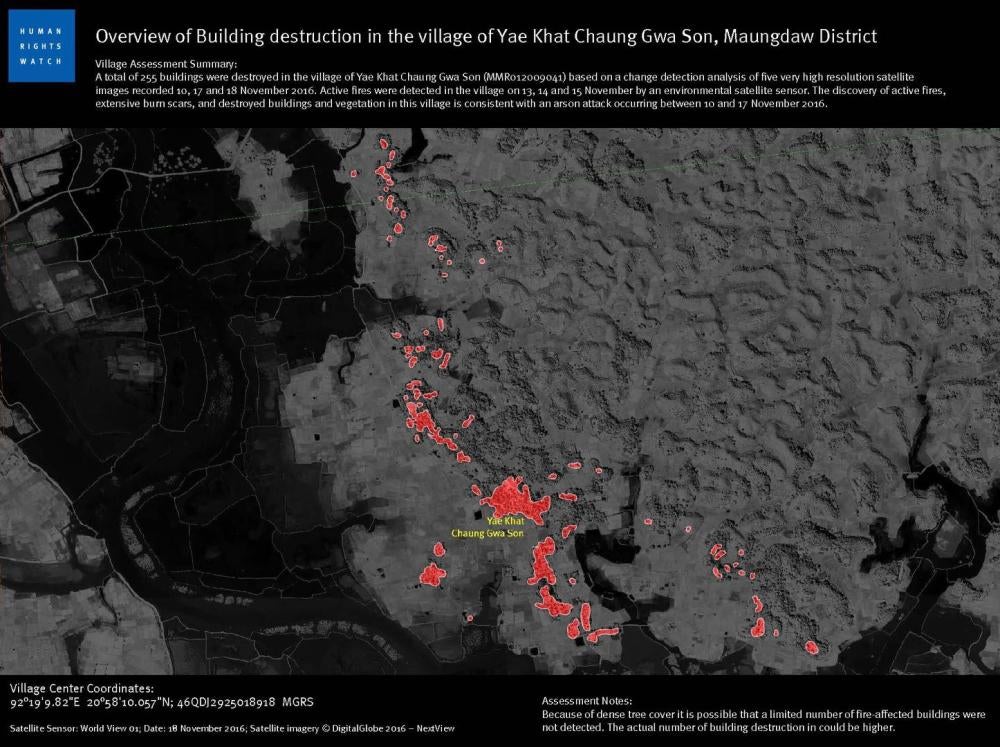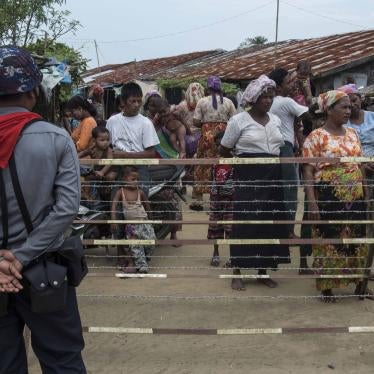(New York) – New satellite imagery of Burma’s Rakhine State shows 820 newly identified structures destroyed in five different ethnic Rohingya villages between November 10-18, 2016, Human Rights Watch said today. The Burmese government should without further delay invite the United Nations to assist in an impartial investigation of the widespread destruction of villages.
The latest images bring the total number of destroyed buildings documented by Human Rights Watch in northern Rakhine State through satellite imagery to 1,250. US Ambassador to the UN Samantha Power, at a November 17 UN Security Council meeting on the deteriorating situation in Rakhine State, called for international observers to be allowed to investigate and for aid groups to have their access restored. After a short visit by diplomats to the area, Yanghee Lee, the UN special rapporteur on Burma, said on November 18, “The security forces must not be given carte blanche to step up their operations under the smokescreen of having allowed access to an international delegation. Urgent action is needed to bring resolution to the situation."
“These alarming new satellite images confirm that the destruction in Rohingya villages is far greater and in more places than the government has admitted,” said Brad Adams, Asia director at Human Rights Watch. “The apparent arson attacks against five Rohingya villages is a matter of grave concern for which the Burmese government needs to investigate and prosecute those responsible. UN participation is crucial for such an investigation to be credible.”
Human Rights Watch identified a total of 820 destroyed buildings in five villages of Maungdaw district from an analysis of very high resolution satellite imagery recorded on November 10, 17, and 18. This damage is in addition to the 430 destroyed buildings Human Rights Watch identified from satellite imagery on November 13. Of the 820 destroyed buildings, 255 were in the village of Yae Khat Chaung Gwa Son; 265 in Dar Gyi Zar; 65 in Pwint Hpyu Chaung; 15 in Myaw Taung; and 220 in Wa Peik (in addition to the 100 which were destroyed earlier in the village).
Human Rights Watch also reviewed thermal anomaly data collected by environmental satellite sensors that detected the presence of multiple active fires burning in the village of Pwint Hpyu Chaung on November 12, in Dar Gyi Zar on November 13, and in Yae Khat Chaung Gwa Son on November 13, 14, and 15. Dense tree cover may have concealed a limited number of additional buildings that were destroyed, making it possible that the actual number is higher.
At a press conference on November 15 in response to Human Rights Watch’s November 13 statement, the Burmese government admitted widespread burning but claimed that the total number of buildings destroyed was significantly lower. The government cited helicopter flyovers of the area to arrive at its figures and blamed unspecified “terrorists” for the burnings.
The new imagery shows village destruction that far exceeds the figures released by the Burmese government, Human Rights Watch said. On November 15, the Burmese military reported that militants burned down 60 homes in Dar Gyi Zar, while the State Counsellor Office’s newly created “Information Committee” reported on November 16 that only 30 buildings were destroyed in the same town. The new imagery shows that 265 buildings have been destroyed in Dar Gyi Zar alone. The State Counsellor’s information committee press release on November 16 mistakenly attributed a claim that all buildings were destroyed in Dar Gyi Zar to Human Rights Watch.
Both the military and the State Counsellor’s information committee reported that 105 buildings were destroyed in Wa Peik village. Satellite imagery collected by Human Rights Watch between November 10-17 shows that an additional 220 buildings were destroyed. This newly documented destruction, coupled with the 100 buildings Human Rights Watch imagery determined were destroyed from images collected between October 9 and November 3, brings the total to 320 buildings destroyed in Wa Peik village.
“On November 15, a government spokesperson suggested that Human Rights Watch was part of a ‘conspiracy’ to harm Burma’s image,” Adams said. “Instead of responding with military-era style accusations and denials, the government should simply look at the facts and take action to protect all people in Burma, whatever their religion or ethnicity.”
The crisis follows violence on October 9, in which gunmen attacked three police outposts in Maungdaw township near the Bangladesh border, leaving nine police officers dead. The government said that the attackers made off with dozens of weapons and thousands of rounds of ammunition. The Burmese government asserts the attack was carried out by a Rohingya group, but actual responsibility remains unclear. A second attack on a border guard post that resulted in the death of a police officer reportedly occurred on November 3.
Immediately after the October 9 attack, government forces declared Maungdaw district an “operation zone” and began sweeps of the area to find the attackers and lost weapons. They severely restricted the freedom of movement of local populations and imposed extended curfews, which remain in place. With the area sealed off to observers, local sources reported that government forces committed serious human rights abuses, including torture, rape, extrajudicial executions, and widespread destruction of buildings, including mosques.
On October 28, Reuters published interviews with Rohingya women who allege that Burmese soldiers raped them. The government also allegedly pressured the Myanmar Times to fire one of its editors who reported allegations of rape by Burmese army soldiers.
The Burmese government conducted a government-supervised tour of some impacted sites in Maungdaw on November 2 and 3 with a nine-member delegation of foreign ambassadors, including the UN Resident Coordinator. The delegation conducted no formal investigation or assessment, but confirmed that they saw burned structures in several towns and spoke with several villagers. Allegations of reprisals against those who spoke to delegation members surfaced shortly after the trip concluded.
Another outbreak of violence reportedly began on November 11. The government reported the deaths of 69 alleged militants and 17 security force personnel. Local groups reported significant civilian casualties, but the lack of access makes all casualty reports difficult to verify. The Burmese military said that helicopter gunships called in to provide air support to its troops were attacked by hundreds of militants.
According to humanitarian aid groups, tens of thousands of people have been displaced by the recent violence, with hundreds attempting to flee to Bangladesh.
The government has responded with blanket denials to allegations that the security forces have committed abuses. Officials maintain that terrorists are responsible for the destruction of the buildings and urge that international journalists investigate the claims. However, the government has continued to block journalists, humanitarian aid workers, and human rights investigators from traveling to the impacted areas.
Burma is obligated under international law to conduct thorough, prompt, and impartial investigations of alleged human rights violations, prosecute those responsible, and provide adequate redress for victims of violations. Standards for such investigations can be found, for example, in the UN Principles on the Effective Prevention and Investigation of Extra-legal, Arbitrary and Summary Executions, and the UN Guidance on Commissions of Inquiry and Fact-Finding Missions. Burma’s failure to conduct such investigations in the past underscores the need for UN assistance, Human Rights Watch said.
In early November, the government granted the World Food Programme (WFP) one-time access to four villages for a one-time food delivery. However, humanitarian aid groups continue to be denied full access, placing tens of thousands of already vulnerable people at greater risk.
Thousands of people impacted by the violence in the villages of Maungdaw have been without aid for six weeks. Despite assurances from the Burmese government that aid access to all impacted areas would be restored, many of the most significantly affected areas remain sealed to humanitarian assessment teams and human rights groups.
“After six weeks of violence with virtually no aid reaching tens of thousands of highly vulnerable people, the government needs to act decisively to assist them,” Adams said. “A government with nothing to hide should have no problem granting access to journalists and human rights investigators.”















